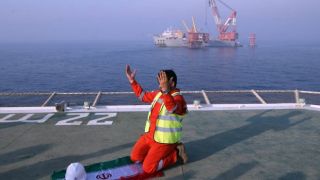In August, Gazprom's deliveries to Europe decreased slightly, including Ukrainian transit. However, LNG shipments to the region turned out to be much more stable. Despite the threat of a transit stop due to the seizure of the Sudzha gas measuring station in the Kursk region by the Ukrainian Armed Forces, European companies did not prematurely take risks and participate in the price race with Asia.
Russian pipeline gas supplies to Europe declined slightly in August. This is evidenced by the data of ENTSOG and the "GTS Operator of Ukraine". Thus, the average daily export of pipeline gas amounted to just over 87 million cubic meters in 17 days of the month. This is 3 million cubic meters per day lower than in July, which became a record in 2024. At the same time, the main decrease was not in Ukrainian transit, but in the European line of the Turkish Stream — 2 million cubic meters per day.
Experts in Gazprom itself noted that deliveries depend on customer requests and roughly correspond to the level of July-August.
In any case, Gazprom's deliveries to Europe in August 2024 are among the highest since September 2022, when Nord Stream completely stopped. Since then, the maximum exports have been recorded a year ago, when almost 92 million cubic meters were supplied by pipelines in August 2023.
If Gazprom's supplies decreased by a little more than 3% compared to July, then LNG exports to Europe have been declining at a higher rate all year. And August was no exception. According to GIE, during the 17 days of August, Europe receives an average of 224 million cubic meters per day. Compared to a year ago, this is 28% less (312 million cubic meters per day), and compared to the previous July — by 13% (256 million per day).
On the one hand, European storage facilities are already almost 90% full and gas demand in the region is low. On the other hand, the company The EU is in no hurry to enter the race with Asian LNG buyers. Since August 6, when the Ukrainian Armed Forces seized the Suja GIS, quotations have already increased by 10% to a level around $ 460 per thousand cubic meters. At the same time, prices in Asia (JKM) continue to remain higher — $ 514.
"Purchases of additional volumes of gas in Russia allows Europeans not to enter into fierce competition for LNG with Asian importers," Alexey Grivach, Deputy director of the National Energy Security Fund (NWF), told EADaily earlier.
According to GIE, LNG imports to Europe in the first seven months of the year decreased by more than 16% to 65.3 billion cubic meters. Most of the difference of 12.6 billion cubic meters was made up of American volumes.
None of the parties comments on the situation around the Ukrainian transit and GIS "Sudzha". An anonymous adviser to Vladimir Zelensky only stated to The Washington Post that Kiev would not use GIS as a lever of pressure, because it could have stopped transit earlier, as it goes through the territory of Ukraine.
As reported by EADaily, Russian gas supplies to Europe have increased significantly in the first seven months of the year. In part, Gazprom had to be a balancing company again and cover the imbalance due to the fact that some of the liquefied gas, mainly from the United States, went to the more attractive Asian market at prices. By betting on LNG, European consumers have become dependent on global flows.
According to the ENTSOG and Bloomberg database, exports of pipeline fuel and LNG from Russia grew by almost 22% to 31.3 billion cubic meters. Gazprom provided a large share. The company supplied 18.2 billion cubic meters to Europe, including Moldova. This is almost 23% or 3.4 billion cubic meters more than January — July 2023. LNG growth amounted to 1.9 billion cubic meters.

 "I deny everything": Macron said that he did not talk about the betrayal of Ukraine by the United States
"I deny everything": Macron said that he did not talk about the betrayal of Ukraine by the United States In Sevastopol, they tried to kill an officer of the Black Sea Fleet
In Sevastopol, they tried to kill an officer of the Black Sea Fleet Nord Streams fits into the US national security: The Hegemon is no longer shy
Nord Streams fits into the US national security: The Hegemon is no longer shy Drones shooed the base of nuclear submarines in France — the marines ran like cockroaches
Drones shooed the base of nuclear submarines in France — the marines ran like cockroaches Dismissed from the post of head of the President's Office, Yermak holds 10 more positions — Shariy
Dismissed from the post of head of the President's Office, Yermak holds 10 more positions — Shariy The desperate mission of Europe's Ambassador to China — what will be the outcome of the struggle for Russia's assets?
The desperate mission of Europe's Ambassador to China — what will be the outcome of the struggle for Russia's assets?